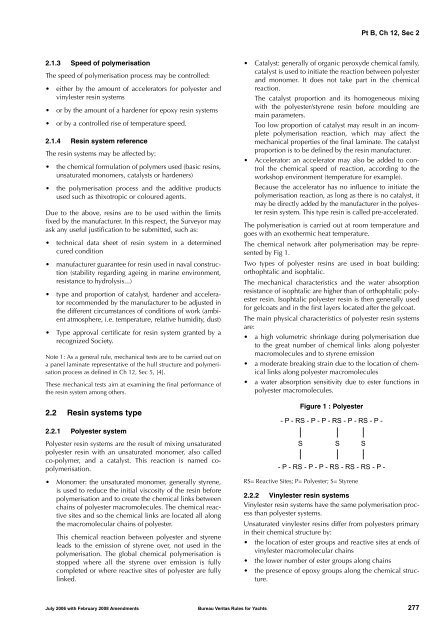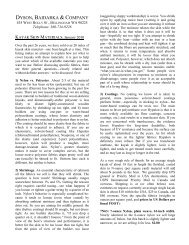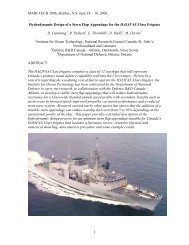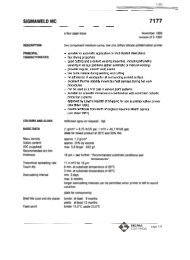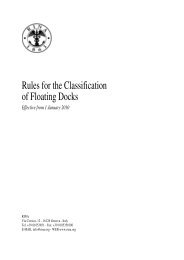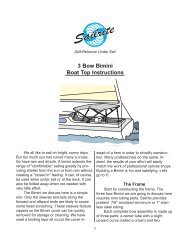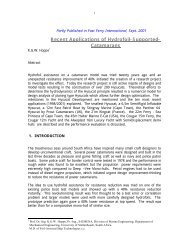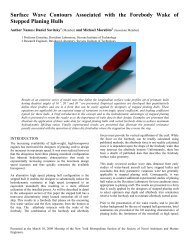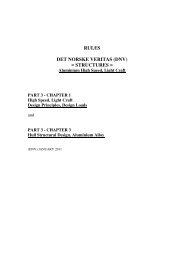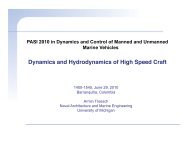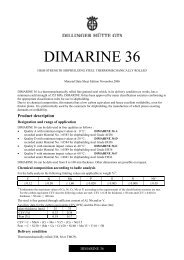SECTION 1 - Boat Design Net
SECTION 1 - Boat Design Net
SECTION 1 - Boat Design Net
Create successful ePaper yourself
Turn your PDF publications into a flip-book with our unique Google optimized e-Paper software.
Pt B, Ch 12, Sec 22.1.3 Speed of polymerisationThe speed of polymerisation process may be controlled:• either by the amount of accelerators for polyester andvinylester resin systems• or by the amount of a hardener for epoxy resin systems• or by a controlled rise of temperature speed.2.1.4 Resin system referenceThe resin systems may be affected by:• the chemical formulation of polymers used (basic resins,unsaturated monomers, catalysts or hardeners)• the polymerisation process and the additive productsused such as thixotropic or coloured agents.Due to the above, resins are to be used within the limitsfixed by the manufacturer. In this respect, the Surveyor mayask any useful justification to be submitted, such as:• technical data sheet of resin system in a determinedcured condition• manufacturer guarantee for resin used in naval construction(stability regarding ageing in marine environment,resistance to hydrolysis...)• type and proportion of catalyst, hardener and acceleratorrecommended by the manufacturer to be adjusted inthe different circumstances of conditions of work (ambientatmosphere, i.e. temperature, relative humidity, dust)• Type approval certificate for resin system granted by arecognized Society.Note 1: As a general rule, mechanical tests are to be carried out ona panel laminate representative of the hull structure and polymerisationprocess as defined in Ch 12, Sec 5, [4].These mechanical tests aim at examining the final performance ofthe resin system among others.2.2 Resin systems type2.2.1 Polyester systemPolyester resin systems are the result of mixing unsaturatedpolyester resin with an unsaturated monomer, also calledco-polymer, and a catalyst. This reaction is named copolymerisation.• Monomer: the unsaturated monomer, generally styrene,is used to reduce the initial viscosity of the resin beforepolymerisation and to create the chemical links betweenchains of polyester macromolecules. The chemical reactivesites and so the chemical links are located all alongthe macromolecular chains of polyester.This chemical reaction between polyester and styreneleads to the emission of styrene over, not used in thepolymerisation. The global chemical polymerisation isstopped where all the styrene over emission is fullycompleted or where reactive sites of polyester are fullylinked.• Catalyst: generally of organic peroxyde chemical family,catalyst is used to initiate the reaction between polyesterand monomer. It does not take part in the chemicalreaction.The catalyst proportion and its homogeneous mixingwith the polyester/styrene resin before moulding aremain parameters.Too low proportion of catalyst may result in an incompletepolymerisation reaction, which may affect themechanical properties of the final laminate. The catalystproportion is to be defined by the resin manufacturer.• Accelerator: an accelerator may also be added to controlthe chemical speed of reaction, according to theworkshop environment (temperature for example).Because the accelerator has no influence to initiate thepolymerisation reaction, as long as there is no catalyst, itmay be directly added by the manufacturer in the polyesterresin system. This type resin is called pre-accelerated.The polymerisation is carried out at room temperature andgoes with an exothermic heat temperature.The chemical network after polymerisation may be representedby Fig 1.Two types of polyester resins are used in boat building:orthophtalic and isophtalic.The mechanical characteristics and the water absorptionresistance of isophtalic are higher than of orthophtalic polyesterresin. Isophtalic polyester resin is then generally usedfor gelcoats and in the first layers located after the gelcoat.The main physical characteristics of polyester resin systemsare:• a high volumetric shrinkage during polymerisation dueto the great number of chemical links along polyestermacromolecules and to styrene emission• a moderate breaking strain due to the location of chemicallinks along polyester macromolecules• a water absorption sensitivity due to ester functions inpolyester macromolecules.Figure 1 : PolyesterS S S2.2.2 Vinylester resin systemsVinylester resin systems have the same polymerisation processthan polyester systems.Unsaturated vinylester resins differ from polyesters primaryin their chemical structure by:• the location of ester groups and reactive sites at ends ofvinylester macromolecular chains• the lower number of ester groups along chains• the presence of epoxy groups along the chemical structure.-P-RS-P-P-RS-P-RS-P--P-RS-P-P-RS-RS-RS-P-RS= Reactive Sites; P= Polyester; S= StyreneJuly 2006 with February 2008 Amendments Bureau Veritas Rules for Yachts 277


